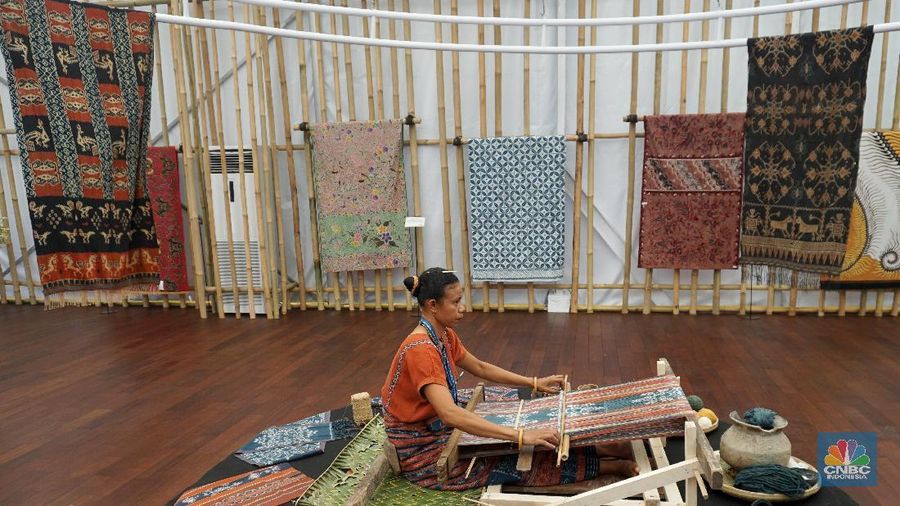IMF-WB ANNUAL MEETING 2018
Indonesia Pavillion: Crafters' Hope for Wider Market Access
Ester Christine Natalia,
CNBC Indonesia
08 October 2018 18:01

Nusa Dua, Bali, CNBC Indonesia - Sugiarto, 53, handed a canting (pen-like tool used in the batik-making process) as he carefully painted a flower on a sheet of white fabric.
He was sitting on a corner at Indonesia Pavilion, with colorful batik displayed on his back. When some visitors came to watch, he offered a small blank fabric so they could join him for batik painting.
He is among several crafters who join live demo session in Indonesia Pavilion, a venue to showcase Indonesia art and crafts, tourism destinations, as well as infrastructure projects during International Monetary Fund (IMF) - World Bank (WB) Annual Meetings 2018.
The venue will be opened from October 8-14 on the side lines of the meetings, which is held in Nusa Dua, Bali.
Sugiarto joined the showcase as a representation of UMKM (micro, small and medium enterprises) Batik Sumber Rejeki from Lasem, Rembang, Central Java. His group was invited by PT Bank Negara Indonesia Tbk (BBNI), which assisted them during the initial phase of developing Lasem-style hand-painted batik.
"At first they gave us some trainings about colour and design, then they invited us to various national exhibitions and built a showroom in our village," he told CNBC Indonesia on Monday (8/10/2018).
BNI started giving them assistance in developing batik business six years ago through trainings and loans. At that time, he borrowed Rp 5 million from BNI by putting marriage certificate as the debt collateral to begin batik painting business.
However, he had learned to make batik for way longer. "As I stopped working due to monetary crisis [in 1998], I started to learn batik painting to help my wife and eventually began the business six years ago," he said.
Sugiarto makes two types of hand-painted batik, namely the natural-dyed batik and the chemical-dyed one. The natural-dye batik takes up to 15 days of production and uses natural colour, such as indigo leaves and mahogany skin. He sells them for Rp 600,000 to Rp 1.5 million per sheet.
Meanwhile, the chemical-dyed one costs Rp 100,000 to Rp 3 million per sheet, depending on the materials, difficulties and pattern. "We use imported paints for the chemical-dye, usually from Arab and China," he said.
He admits that market outreach for Lasem batik is still limited. He and his fellows only sell them through local showrooms and sometimes in exhibitions-which usually happen for 3-4 times in a year. Occasionally, his group receives orders from local government.
"Our turnover is around Rp 5 million- Rp 7 million a month," he said, while expressing his hope to grab wider market through Indonesia Pavilion and IMF-WB Annual Meetings 2018.
"Hopefully hand-painted batik can go international and we get a chance to export [our products], or at least they become aware of hand-painted batik."
Rosvita, 32, which came all the way from Flores, East Nusa Tenggara also expressed the same hope for her group's handwoven fabrics.
Her group, named Watubo, is usually able to produce up to 200 handwoven fabrics in a month.
Similar with Sugiarto, they also use natural resources in the colouring process. "We only use plants for the colour. Thus, if someone looks for chemical-dyed fabrics, we always suggest them to go to the market."
The handwoven fabrics, which can take up to three months of production time, are sold for Rp 200,000 to Rp 6 million, depends on the size and motifs. The group is pocketing around Rp 50 million-Rp 60 million in turnover per month.
Rosvita hopes that the showcase in Indonesia Pavilion can help her crafts to get global-wide recognition. "So far, we only cooperate with one brand that uses our fabrics for their main materials. We hope to get more partnerships and promotions through this event," she said.
Indonesia Pavilion is a joint cooperation between State-Owned Enterprises Ministry, Maritime Affairs and Fisheries Ministry, Energy and Mineral Resources Ministry, Communication and Information Ministry, Finance Ministry, as well as Creative Economy Agency.
This venue showcases interesting facts about Indonesia namely developments, businesses, national strategic projects, tourist destinations and crafts and cultures. It is aimed to be a window for international delegates and investors to take a glimpse about Indonesia's vast potential.
(dob) Next Article Layani Delegasi, BNI Sediakan Tukar Valas Selama IMF-WB 2018
He was sitting on a corner at Indonesia Pavilion, with colorful batik displayed on his back. When some visitors came to watch, he offered a small blank fabric so they could join him for batik painting.
Sugiarto joined the showcase as a representation of UMKM (micro, small and medium enterprises) Batik Sumber Rejeki from Lasem, Rembang, Central Java. His group was invited by PT Bank Negara Indonesia Tbk (BBNI), which assisted them during the initial phase of developing Lasem-style hand-painted batik.
"At first they gave us some trainings about colour and design, then they invited us to various national exhibitions and built a showroom in our village," he told CNBC Indonesia on Monday (8/10/2018).
BNI started giving them assistance in developing batik business six years ago through trainings and loans. At that time, he borrowed Rp 5 million from BNI by putting marriage certificate as the debt collateral to begin batik painting business.
However, he had learned to make batik for way longer. "As I stopped working due to monetary crisis [in 1998], I started to learn batik painting to help my wife and eventually began the business six years ago," he said.
Sugiarto makes two types of hand-painted batik, namely the natural-dyed batik and the chemical-dyed one. The natural-dye batik takes up to 15 days of production and uses natural colour, such as indigo leaves and mahogany skin. He sells them for Rp 600,000 to Rp 1.5 million per sheet.
Meanwhile, the chemical-dyed one costs Rp 100,000 to Rp 3 million per sheet, depending on the materials, difficulties and pattern. "We use imported paints for the chemical-dye, usually from Arab and China," he said.
He admits that market outreach for Lasem batik is still limited. He and his fellows only sell them through local showrooms and sometimes in exhibitions-which usually happen for 3-4 times in a year. Occasionally, his group receives orders from local government.
"Our turnover is around Rp 5 million- Rp 7 million a month," he said, while expressing his hope to grab wider market through Indonesia Pavilion and IMF-WB Annual Meetings 2018.
"Hopefully hand-painted batik can go international and we get a chance to export [our products], or at least they become aware of hand-painted batik."
Rosvita, 32, which came all the way from Flores, East Nusa Tenggara also expressed the same hope for her group's handwoven fabrics.
Her group, named Watubo, is usually able to produce up to 200 handwoven fabrics in a month.
Similar with Sugiarto, they also use natural resources in the colouring process. "We only use plants for the colour. Thus, if someone looks for chemical-dyed fabrics, we always suggest them to go to the market."
The handwoven fabrics, which can take up to three months of production time, are sold for Rp 200,000 to Rp 6 million, depends on the size and motifs. The group is pocketing around Rp 50 million-Rp 60 million in turnover per month.
Rosvita hopes that the showcase in Indonesia Pavilion can help her crafts to get global-wide recognition. "So far, we only cooperate with one brand that uses our fabrics for their main materials. We hope to get more partnerships and promotions through this event," she said.
Indonesia Pavilion is a joint cooperation between State-Owned Enterprises Ministry, Maritime Affairs and Fisheries Ministry, Energy and Mineral Resources Ministry, Communication and Information Ministry, Finance Ministry, as well as Creative Economy Agency.
This venue showcases interesting facts about Indonesia namely developments, businesses, national strategic projects, tourist destinations and crafts and cultures. It is aimed to be a window for international delegates and investors to take a glimpse about Indonesia's vast potential.
(dob) Next Article Layani Delegasi, BNI Sediakan Tukar Valas Selama IMF-WB 2018
Tags
Related Articles
Recommendation

Most Popular



